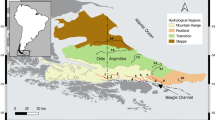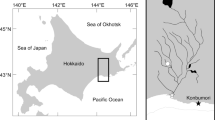Abstract
Sustainable conservation management of chum salmon in Japan requires ecological information on wild fish. This study investigated the spawning timing in a nonstocked river and the occurrence of wild fry in a surf zone in Niigata Prefecture. Most redds were observed from mid-October to mid-December on riverbeds having stream water of variable but cold temperatures above 5.4 °C. Chum salmon fry (< 41 mm), identified as wild based on comparison with the expected minimum size of hatchery fish (> 41.2 mm), were collected at the surf zone generally from early March to early May when the sea surface temperature (SST) was 7.4−17.5 °C. This period largely matched the predicted time of emergence based on the surveyed river cumulative water temperature. A generalized linear model predicted that the probability of occurrence would decrease as SST increased, being 42.5% even when SST was 15 °C. Hatchery fish are stocked by late March in Niigata Prefecture. Our results reveal that wild chum salmon fry at the southern limits of their distribution, which is affected by the Tsushima Warm Current, enter the sea when SST is relatively high, mainly from March to April, and even in May, 2 months after the end of hatchery stocking.






Similar content being viewed by others
References
Araki H, Schmid C (2010) Is hatchery stocking a help or harm? Evidence, limitations and future directions in ecological and genetic surveys. Aquaculture 308:S2–S11
Aruga N, Morita K, Okamoto M (2019) Toward a coexistence between human and wild salmon in urban rivers. Japan J Ecol 69:229–237 (in Japanese)
Bax NJ (1983) Early marine mortality of marked juvenile chum salmon (Oncorhynchus keta) released into Hood Canal, Puget Sound, Washington, in 1980. Can J Fish Aquat Sci 40:426–435
Beacham TD, Murray CB (1987) Adaptive variation in body size, age, morphology, egg size, and developmental biology of chum salmon (Oncorhynchus keta) in British Columbia. Can J Fish Aquat Sci 44:244–261
Brannon EL (1987) Mechanisms stabilizing salmonid fry emergence timing. In: Smith et al (eds) Sockey salmon (Oncorhynchus nerka) population biology and future management. Can Spec Publ Fish Aquat Sci, Ottawa, pp 120–124
Fukuwaka M, Suzuki T (2002) Early sea mortality of mark-recaptured juvenile chum salmon in open coastal waters. J Fish Biol 60:3–12
Gallagher SP, Hahn PK, Johnson DH (2007) Redd counts. In: Johnson et al (eds) Salmonid field protocols handbook: techniques for assessing status and trends in salmon and trout populations. American Fisheries Society, Bethesda, Maryland, pp 197–234
Healey M (1982) Timing and relative intensity of size-selective mortality of juvenile chum salmon (Oncorhynchus keta) during early sea life. Can J Fish Aquat Sci 39:952–957
Iida M, Yoshino K, Katayama S (2018) Current status of natural spawning of chum salmon Oncorhynchus keta in rivers with or without hatchery stocking on the Japan Sea side of northern Honshu, Japan. Fish Sci 84:453–459
Irie T (1990) Ecological studies on the migration of juvenile chum salmon, Oncorhynchus keta, during early ocean life. Bull Seikai Nat Fish Res Ins 68:1–142 (in Japanese with English abstract)
Iseki T, Miyauchi Y, Fujii T (2012) Residence pattern of the ayu Plecoglossus altivelis altivelis larvae and juveniles occurring in the surf zone of a sandy beach, Niigata Prefecture, northern Sea of Japan. Fish Sci 78:55–65
Kaeriyama M (1999) Hatchery programmes and stock management of salmonid populations in Japan. In: Howell BR et al (eds) Stock enhancement and sea ranching. Blackwell, Oxford, pp 153–167
Kaeriyama M, Edpalina RR (2004) Evaluation of the biological interaction between wild and hatchery populations for sustainable fisheries and management of Pacific salmon. In: Leber K et al (eds) Stock enhancement and sea ranching, 2nd edn. Blackwell, Oxford, pp 247–259
Kaeriyama M, Seo H, Kudo H, Nagata M (2012) Perspectives on wild and hatchery salmon interactions at sea, potential climate effects on Japanese chum salmon, and the need for sustainable salmon fishery management reform in Japan. Environ Biol Fish 94:165–177
Kaeriyama M, Seo H, Qin YX (2014) Effect of global warming on the life history and population dynamics of Japanese chum salmon. Fish Sci 80:251–260
Kitada S (2014) Japanese chum salmon stock enhancement: current perspective and future challenges. Fish Sci 80:237–249
Kitada S (2020) Lessons from Japan marine stock enhancement and sea ranching programmes over 100 years. bioRxiv, 828798
Kobayashi T (1980) Salmon propagation in Japan. In: Thorpe JE (ed) Salmon ranching. Academic Press, London, pp 91–107
Mayama H, Ishida Y (2003) Japanese studies on the early ocean life of juvenile salmon. N Pac Anadr Fish Comm Bull 3:41–67
Miyakoshi Y (2014) Improvement of enhancement and conservation techniques for salmon stocks. Nippon Suisan Gakkaishi 80:674–676 (in Japanese)
Miyakoshi Y, Urabe H, Saneyoshi H, Aoyama T, Sakamoto H, Ando D, Kasugai K, Mishima Y, Takada M, Nagata M (2012) The occurrence and run timing of naturally spawning chum salmon in northern Japan. Environ Biol Fish 94:197–206
Morita K (2014) Japanese wild salmon research: toward a reconciliation between hatchery and wild salmon management. NPAFC Newsletter 35:4–14
Morita K (2020) Toward sustainable salmon fisheries under environmental stepwardship. Nippon Suisan Gakkaish 86:180–183 (in Japanese)
Morita K, Ohkuma K (2015) Chum salmon: existence and conservation of wild fish that have persisted under hatchery programs. Jpn J Ichthyol 62:189–195 (in Japanese)
Morita K, Saito T, Miyakoshi Y, Fukuwaka MA, Nagasawa T, Kaeriyama M (2006) A review of Pacific salmon hatchery programmes on Hokkaido Island, Japan. ICES J Mar Sci 63:1353–1363
Morita K, Takahashi S, Ohkuma K, Nagasawa T (2013) Estimation of the proportion of wild chum salmon Oncorhynchus keta in ]apanese hatchery rivers. Nippon Suisan Gakkaish 79:206–213 (in Japanese with English abstract)
Morita K, Fukuzawa H, Suzuki K (2019) Comparison of fry-to-adult survival rates between wild and hatchery chum salmon in the Chitose River, Hokkaido, Japan. J Fish Tech 11:9–14 (in Japanese with English abstract)
Mueter FJ, Peterman RM, Pyper BJ (2002) Opposite effects of ocean temperature on survival rates of 120 stocks of Pacific salmon (Oncorhynchus spp.) in northern and southern areas. Can J Fish Aquat Sci 59:456–463
Nagata M, Miyakoshi Y, Ando D, Fujiwara M, Sawada M, Shimada H, Asami H (2007) Influence of coastal seawater temperature on the distribution and growth of juvenile chum salmon, with recommendations for altered release strategies. N Pac Anadr Fish Comm Bull 4:223–235
Nagata M, Miyakoshi Y, Urabe H, Fujiwara M, Sasaki Y, Kasugai K, Torao M, Ando D, Kaeriyama M (2012) An overview of salmon enhancement and the need to manage and monitor natural spawning in Hokkaido, Japan. Environ Biol Fish 94:311–323
Nogawa H (2010) Development of artifcial salmon propagation in Japan—a foreword. J Fish Tech 3:1–8 (in Japanese with English abstract)
Ohnuki T, Morita K, Tokuda H, Okamoto Y, Ohkuma K (2015) Numerical and economic contributions of wild and hatchery pink salmon to commercial catches in Japan estimated from mass otolith markings. N Am J Fish Manag 35:598–604
Paquet PJ, Flagg T, Appleby A, Barr J, Blankenship L, Campton D, Delarm M, Evelyn T, Fast D, Gislason J, Kline P, Maynard D, Mobrand L, Nandor G, Seidel P, Smith S (2011) Hatcheries, conservation, and sustainable fisheries—achieving multiple goals: results of the hatchery scientific review group’s Columbia River basin review. Fisheries 36:547–561
R Core Team (2018) R: A language and environment for statistical computing. R Foundation for Statistical Computing, Vienna, Austria, URL https://www.R-project.org/
Salo EO (1991) Life history of chum salmon (Oncorhynchus keta). In: Groot C, Margolis L (eds) Pacific salmon life histories. UBE Press, British Columbia, pp 231–309
Shimizu T, Ban M, Miyauchi Y, Umeda K, Nakano K, Fujii M, Mayama H (2016) Nutritional condition of hatchery and wild chum salmon Oncorhynchus keta fry migrating down the Chitose River. J Fish Tech 8:89–94 (in Japanese with English abstract)
Sturdevant MV, Fergusson E, Hillgruber N, Reese C, Orsi J, Focht R, Wertheimer A, Smoker B (2012) Lack of trophic competition among wild and hatchery juvenile chum salmon during early marine residence in Taku Inlet, Southeast Alaska. Environ Biol Fish 94:101–116
Suzuki T, Okamoto M, Aruga N (2005) Natural spawning of chum salmon in the Toyohira River. Hokkaido NPAFC Tech Rep 6:121
Tago T (2008) Last resident period and size of chum salmon fry in the Jinzu River during seaward migration. Bull Toyama Pref Res Inst 19:19–28 (in Japanese with English abstract)
Takami T, Kinoshita T (1990) Morphological Comparisons of Charr, Salvelinus leucomaenis (Pallas), obtained from Lake Shikotsu and the Moheji River in Hokkaido, Japan. Bull Fac Fish Hokkaido Univ 41:121–130 (in Japanese with English abstract)
Tokuhara T, Kishi D, Hara T, Kumazaki H (2010) Egg eyeing rates and physical characteristics of spawning redds of stocked amago salmon Oncorhynchus masou ishikawae in a stream. Nippon Suisan Gakkaishi 76:370–374 (in Japanese with English abstract)
Urawa S, Beacham TD, Fukuwaka MA, Kaeriyama M (2018) Ocean ecology of chum salmon. In: Beamish RJ (ed) The ocean ecology of pacific salmon and trout. American Fisheries Society, Bethesda, pp 161–317
Yamamoto K, Imai M (1990) Oou coastal area, II physics. In: Coastal Oceanography Research Committee, The Oceanographical Society of Japan et al (eds) Coastal Oceanography of Japanese Island, supplementary volume. Tokai University Press, Tokyo, pp 805–819 (in Japanese)
Acknowledgements
We are grateful to Dr. Toru Nagasawa (Fisheries Resources Institute, Japan Fisheries Research and Education Agency) for valuable comments and encouragement on an earlier draft of the paper. We thank Dr. Kunihiro Fujiwara (Demersal Fish Resources Division, Fisheries Stock Assessment Center, Japan Fisheries Research and Education Agency), Masato Haga, Yukiharu Goda, and Yasuaki Yokoda (Salmon Research Department, Fisheries Resources Institute, Japan Fisheries Research and Education Agency), who assisted at various times with fieldwork. We also thank Yasuyuki Miyauchi (Salmon Research Department, Fisheries Resources Institute, Japan Fisheries Research and Education Agency) for providing data on size of hatchery fish. The staff of the Kitakanbara Branch of the Fishery Cooperative Association of Niigata supported us during this investigation. We would like to thank Editage (www.editage.com) for English language editing. Finally, we are particularly grateful for the constructive comments made by Dr. Koh Hasegawa (editor of Fisheries Science) and two anonymous reviewers that further improved the manuscript.
Author information
Authors and Affiliations
Corresponding author
Additional information
Publisher’s Note
Springer Nature remains neutral with regard to jurisdictional claims in published maps and institutional affiliations.
Supplementary Information
Below is the link to the electronic supplementary material.
Rights and permissions
About this article
Cite this article
Iida, M., Yagi, Y. & Iseki, T. Occurrence of wild chum salmon fry in the surf zone, and spawning and emergence timing in the adjacent nonstocked river in Niigata Prefecture, Japan. Fish Sci 87, 549–557 (2021). https://doi.org/10.1007/s12562-021-01535-4
Received:
Accepted:
Published:
Issue Date:
DOI: https://doi.org/10.1007/s12562-021-01535-4




